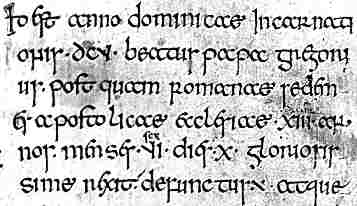Script Type : minuscule, with occasional majuscule letter forms
Date : This particular variant dates from the 9th century and has characteristics of insular half uncial as well as insular minuscule
Location : England and Ireland
Function : book hand


























Distinctive letters : The letters n and r have both a minuscule and a majuscule form, as in insular half uncial script. a also has a half uncial form of a figure of eight on its side. There are two forms of s, one of which is a bit tricky as it looks like an r that projects below the line, while the minuscule form of r has a tendency to look a bit like an n. There are also two forms of d. The letter g is open with the lightning bolt form. t is short with a broad cross stroke.
There is no example shown of j, k, w or z.
A characteristic of insular minuscule is the presence of ligatures, in which certain letters change their form when used in combination with others. The letter e, for example, becomes raised and open in the following
 en
en  er
er  es
es  ex
ex
Combinations of letters can share elements as in the following
 ati
ati  est
est
The script may appear difficult because of the unfamiliar letter forms, but it is open and clear and the words are usually well spaced. It's really a case of getting the eye in, and it is very elegant.
The passage illustrated includes Roman numerals and an abbreviation for est which is particular to Anglo-Saxon and Irish writing. Pass the cursor slowly over the lines of text for decoding clues. And the quick quiz question is, exactly how long did Pope Gregory reign before he died?
Paleography
exercises for this example using Flash ![]()
Requires Flash 5 plugin
If you are looking at this page without frames, there is more information about medieval writing to be found by going to the home page (framed) or the site map (no frames).